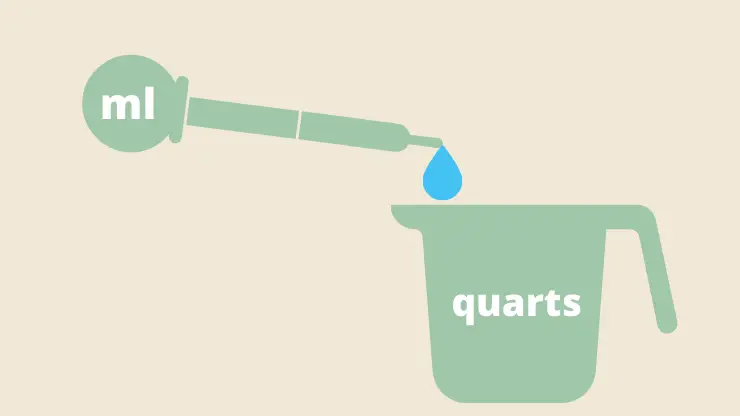One common conversion from the metric to the Imperial system, which is used for liquids is to convert ml to quarts.
How many milliliters are in a quart?
Here is the ml to quart conversion:
1 ml = 0.00105669 quarts
This formula is helpful if you want to use the correct portion on your grilled foods of milliliters of the barbeque sauce that you buy in quarts. And then, after you make a delicious mess, learn how to clean a rock reversible grill here.
How many quarts are in a milliliter?
Here is the quart to ml conversion:
1 quart = 946.353 ml
How to convert qt to ml?
To convert quarts to milliliters, take the number of quarts and multiply by 946.353 (ml per qt.). The formula makes it easy to notice that to get the liters per quart multiple by .946353. Do you see how it works?
When 1,000 ml equals one liter, you move the decimal place over three places for the 1,000 ml to liter conversion to get liters per quart.
In this video from chem101csub, there is a math demonstration of converting quarts to liters.
Now, you should feel confident and work with these formulas as you desire.
If you like my articles, here is another one that you can enjoy. Learn if you can deep fry frozen chicken wings here.
Milliliters to Quarts Formula
It is helpful to start with the liters to quarts conversion formula:
- 1 liter = 1.05669 U.S. quarts
- 1 quart = 0.946353 liters
and then compare the smaller sizes of milliliters (ml) to ounces (oz.):
- 1 ml = 0.033814 oz.
- 1 oz. = 29.5735 ml
and understand how they are related as small to larger sizes in the same systems:
- 1,000 ml = 1 liter
- 32 U.S. fluid oz. = 1 U.S. quart
- 4 quarts = 1 U.S. gallon
In this video, produced by Margaret McKeeman, she shows how to use conversion tables that may not have the exact formula for a direct conversion.
This video shows how to use math to work with intermediary conversions to achieve the desired result.
How do you measure?
The metric system is the standard in more countries than any other system, so it is very useful to know.
There is a common misperception discussed on the Taking Measure blog of the National Institute of Standards and Technology (NIST). Many incorrectly think there are only three countries in the world that do not use the metric system: Liberia, Myanmar, and the United States.
It is the case that the use of the International System of Units (SI) is mandatory in some countries and voluntary in others. However, the U.S. has a long history of using the metric system.
The “Acceptable To Italians Index” is my new favorite set of metrics pic.twitter.com/AaaVXMownP
— Armand Domalewski (@ArmandDoma) February 4, 2022
It has been legal to use the metric system in the United States since 1866. The United States signed the Treaty of the Meter in 1875. In 1975, President Gerald R. Ford signed the Metric Conversion Act to encourage the system’s use in America. By 1988, the metric system became the chosen system of weights and measurements for all of U.S. commerce.
Take a break and learn about fire safety in the kitchen. Check out one of my newest articles on how you can microwave paper plates safely.
History
In 1799, the metric system became the standard of measurements used in France, right after the French Revolution. Although it is used widely globally as the “International System of Units,” a different measurement system is in place in the United States that goes along with the metric system.
Y’all the imperial system is getting out of hand… pic.twitter.com/bN4rLnjY6C
— Nic Harriel, OMS IV 🏳️🌈🩺 (@nicholasharriel) February 7, 2022
The United States still uses the Imperial system, which has its origins in England. Many of the measurements in that system relate to body parts, such as feet.
Final Thoughts
The Imperial system usage in tandem still happens in a few countries like the U.S., but the metric system is the dominant one now. The metric IS system is the most useful for practical purposes. To do any conversions necessary, be sure to keep this information about the ml to quarts converter handy.
- Lava Rocks Vs. Fire Glass – What Is Better for a Fire Pit? - November 15, 2023
- How to Light a Propane/Gas Fire Pit with a Manual or Electronic Ignition System - November 8, 2023
- How Long Does a Propane Tank Last for a Fire Pit - October 9, 2023


